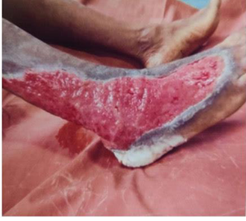A Study Evaluating the Uptake of Split-Thickness Skin Grafts in Relation to the Initial Postoperative Dressing Applied on Day Third Versus Day Fifth
Main Article Content
Abstract
Skin grafting is a technique used to restore the continuity of the skin. The primary reasons for the failure of skin grafts include seroma, haematoma, or infection. These issues hinder the adherence of the graft and its revascularization, leading to a higher likelihood of graft rejection, especially in the early postoperative phase. Aim: The goal of the study was to analyses graft acceptance, rejection resulting from infection or seroma, and the timing of the first postoperative dressing on day third compared to day fifth. A comparative and prospective study was carried out at our institution from November 2021 to April 2024, involving 200 patients who received split-thickness skin grafting (STSG) and were divided into two groups. In Group A, the initial postoperative dressing was applied on day 3, while for Group B, it was done on day 5. The second postoperative dressing took place two days after the first. The grafted area was evaluated for the percentage of graft uptake, incidence of seroma, rejection, and infection, both through clinical observation and culture sensitivity testing. Findings revealed that the average graft uptake in group A was 88.5%, compared to 81.93% in group B during the first dressing, while during the second dressing, group A showed 88.24% and group B showed 78.03%, with the data being statistically significant, indicating a lower rate of rejection and infection in group A. Seroma occurred in 82.01% of cases in group A and 74.02% in group B during the first postoperative dressing, decreasing to 6.0% and 12.0%, respectively, by the second dressing. Performing the first postoperative dressing on third day after skin grafting significantly enhances the final graft uptake and decreases the rejection rate by minimizing both seroma and infection.
Article Details

This work is licensed under a Creative Commons Attribution-ShareAlike 4.0 International License.
References
Gibson T, Rudolph R, Ballantyne D. Physical properties of skin and skin grafts. McCartly Phys Propert. 1990;1(1):207-75.
Shenaq SM, Bienstock A, Kim JYS. Plastic and reconstructive surgery. Schwartz's principles of surgery. 8th ed. New York: 2005: 1792.
McGrath MH, Pomerantz J. Plastic surgery. Sabiston textbook of surgery. 19th ed. Philadelphia: Elsevier Saunders; 2012: 1917. .
Herskovitz I, Hughes OB, Macquhae F, Rakosi A, Kirsner R. Epidermal skin grafting. Int Wound J. 2016 Sep;13 Suppl 3(Suppl 3):52-6.
Converse JM, McCarthy JG, Brauer RO, Ballantyne DL. Transplantation of skin: grafts and flaps. Reconstruc Plast Surg. 1977;1:152-239.
Unal S, Ersoz G, Demirkan F, Arslan E, Tütüncü N, Sari A. Analysis of skin-graft loss due to infection: infection-related graft loss. Ann Plast Surg. 2005 Jul;55(1):102-6.
Cuschieri S. The STROBE guidelines. Saudi J Anaesth. 2019 Apr;13(Suppl 1):S31-S34.
Arif T, Sami M. Calculating area of graft required for vitiliginous areas during split-thickness skin grafting: A simple, accurate, and cost-effective technique. J Cutan Aesthet Surg. 2017;10(3):160.
Sheridan J. Coakes. SPSS Version 20.0 for Windows: Analysis without Anguish. Wiley online library October 2017
Slobodan Jankovic .Tests for Comparison of Two Groups: Student’s T-test, Mann-Whitney U-test and Chi-square Test.
Ünal S, Ersoz G, Demirkan F, Arslan E, Tütüncü N, Sari A. Analysis of skin-graft loss due to infection: infection-related graft loss. Ann Plast Surg. 2005;55(1):102-6.
Younes N, Albsoul A, Badran D, Obedi S. Wound bed preparation with 10 percent phenytoin ointment increases the take of split-thickness skin graft in large diabetic ulcers. Dermatol Online J. 2006;12(6):5.
Maher A. Establishing a consensus for the surgical management of chronic burn wounds: A randomised prospective comparative study. Egypt, J Plast Reconstr Surg. 2009;33(1):31-7.
Rituraj AS, Chatterjee S. Topical phenytoin: role in diabetic ulcer care. IJIMS. 2015;2(6):93-7.


